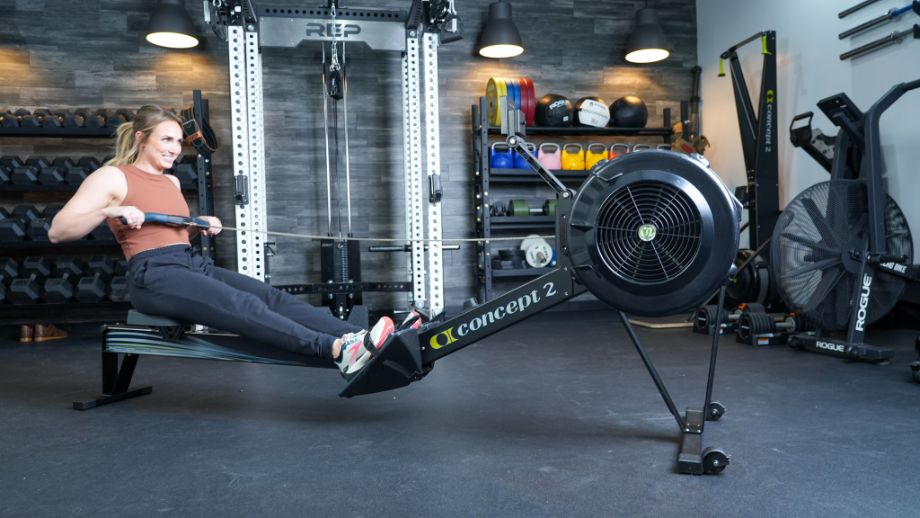We test and review fitness products based on an independent, multi-point methodology. If you use our links to purchase something, we may earn a commission. Read our disclosures.
In some strength circles, cardiovascular exercise might be a dirty word, but it shouldn’t be. Cardio, known in some circles as punishment for last night’s juicy hamburger, is for much more than burning calories and reducing the size of your love handles.
Cardiovascular exercise is a physical activity with many benefits besides weight loss, including reducing heart disease risk factors, helping you remember where you left your keys, and improving your mental health. All you have to do is strap on a pair of shoes and go, and that’s not too much to ask.
Here we’ll dive into some best bodyweight and equipment-based cardiovascular exercises, the benefits of performing cardio, and FAQ to get the best out of your cardio workouts.
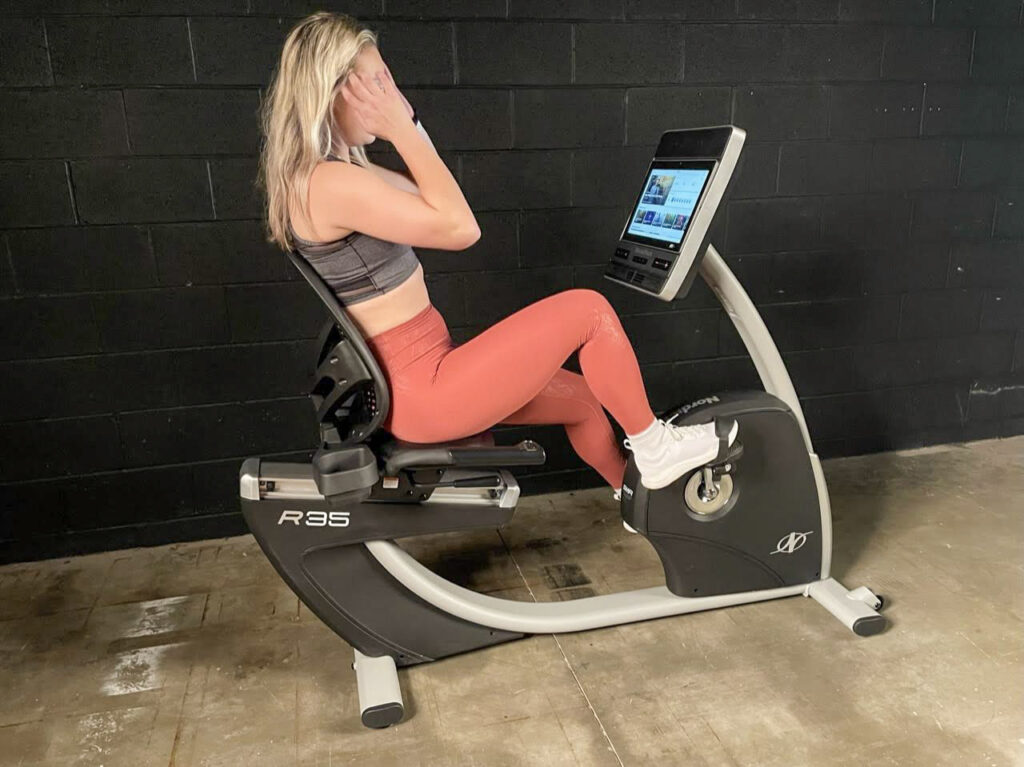
What Is Cardio Exercise?
Cardio exercise is short for cardiovascular exercise and is an activity that involves the heart, lungs, and blood vessels. Cardiovascular exercise, also known as aerobic exercise, is any rhythmic moderate-intensity activity involving the upper and lower body’s major muscles (or both) that raise the heart rate for a sustained time.
Deoxygenated blood returns to the heart and picks up oxygen to send back to your working muscles. How efficiently this happens and how intense the activity determines how high your heart rate goes. Examples of cardiovascular exercise include running, biking, rowing, swimming, and walking.
6 Bodyweight Cardiovascular Exercises
Machine- and equipment-based cardio exercises are great, but what is often lost in the wash is the best and most available tool in the toolbox, your body weight. Some common examples of bodyweight cardio exercises include jumping jacks, mountain climbers, and butt kicks.
Here are six of our favorite bodyweight cardio exercises to get a sweat on in the comfort of your own home.
Jump Squats
Jump squats, or what some call triple extension, is the extension of the ankle, knee, and hip joints simultaneously. When you do this movement, like a hybrid squat and calf raises at speed, all muscles from head to toe, including the most important of all, your heart, are trained.
How to Do It
- Stand with your feet hip-width apart and arms by your side.
- Drop into a squat, touch your ankles with your hands, and quickly come up until your feet are off the ground and your arms are above your head.
- Repeat as one continuous movement for time or reps.
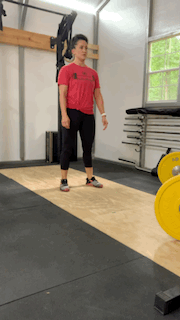
High Knee Skip
High knee skips are either performed in place or moving forward. It is a matter of personal preference and space. The high knee skip will strengthen your core, hip flexors, and single-leg balance. Plus, it will get your heart rate up.
How to Do It
- Stand with feet hip-width apart and bend both of your arms to 90 degrees.
- Skip in place by hopping on your right leg while bringing your left knee toward your chest.
- Repeat on the other side while skipping and pumping your arms.
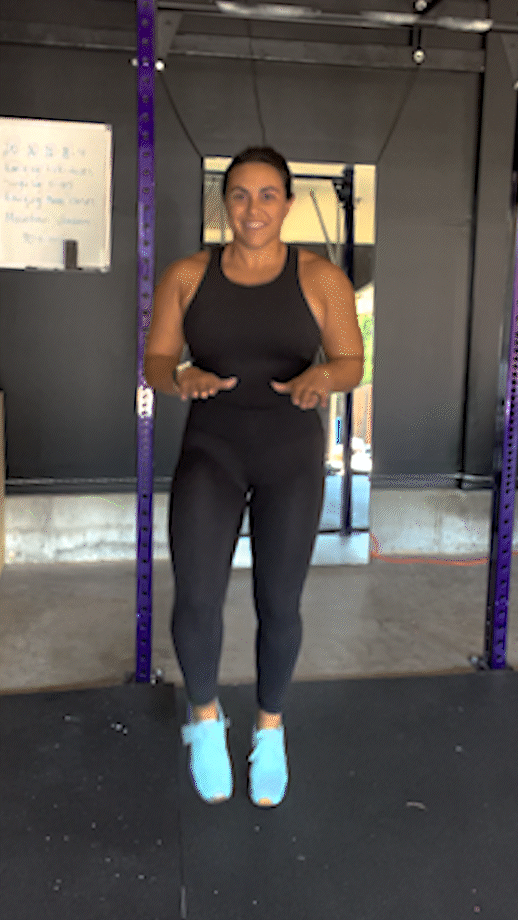
Windmill Side Lunge

Windmill side lunges with the arm action while going from side to side will simultaneously raise your heart rate and improve your hip mobility.
How to Do It
- Stand up, hold your hands together, and raise them above your head.
- Step out to the right with your right leg, pushing your hips back while the left leg is straight.
- Bring your arms to the inside of the right thigh and step back.
- Bring your arms overhead and repeat on the other side.
Burpee
You either love or hate burpees, but you can’t deny they will increase your heart rate when performed well. Full-body moves like burpees build and improve your lower and upper body muscle strength and endurance.
How to Do It
- From the standing position, bend over or squat down and place both hands on the ground.
- Push your hands into the floor and thrust your legs backward until you’re in the push-up position.
- Bring your legs back in, stand up and jump in the air.
- Repeat for either reps or time.
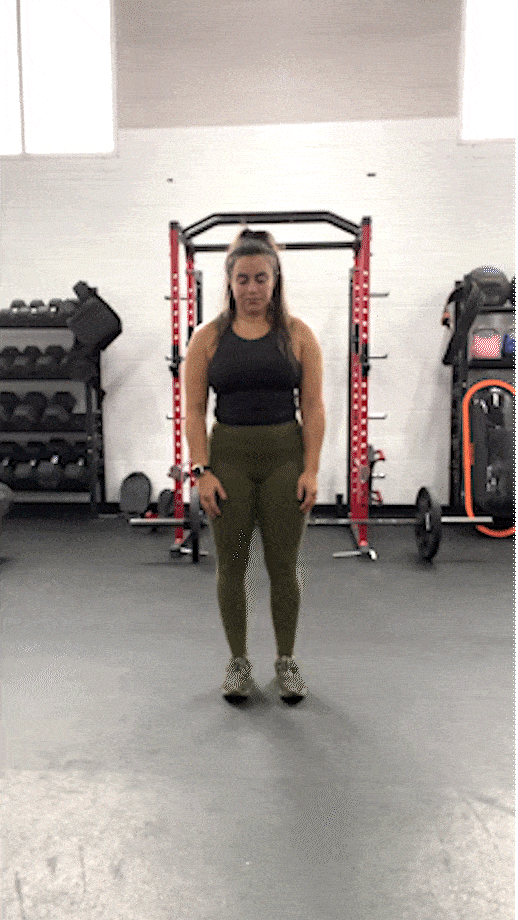
Skater Hops
Skater hops, or ice skaters, mimic an ice skater gliding gracefully on the ice, hence the name, and it’s a great cardiovascular exercise because it trains the quads, hamstring, and glutes. Ice skaters will test your strength, balance, and coordination.
How to Do It
- Stand on your right foot with your left leg bent and bring it behind you.
- Jump to the side, and land on your left foot.
- Stick the landing, reset and jump back sideways to your starting foot.
- Continue this back and forth for reps or time.
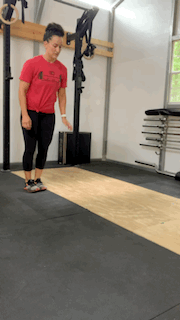
360 Squat Jump

Squats jumps are awesome bodyweight power and cardiovascular exercise to improve your power and conditioning. Adding rotation to the mix trains rotational strength, agility, power, and heart rate.
How to Do It
- Stand in your preferred squat stance with arms by your side.
- Squat down, pull your arms back, explode up, and throw your arms in the same direction as the turn, turning 180 or 360, depending on your ability—land in a half-squat position and repeat in the same direction.
- Repeat in the opposite direction and alternate sides for reps.
6 Equipment-Based Cardiovascular Exercises
If you have a home gym, are looking to build one, or go to a commercial gym, here are several machine-based cardio exercises you can do no matter your fitness level.
Note: Please include a low-intensity warmup and cooldown when doing the following equipment-based cardio exercises.
Treadmill
Regarding cardio training, the treadmill is an excellent choice for high-intensity interval training (HIIT) or to enjoy brisk walking when the weather is not on your side. On the treadmill, you can adjust the speed, incline, and duration while listening to your favorite tunes to make your session more enjoyable.
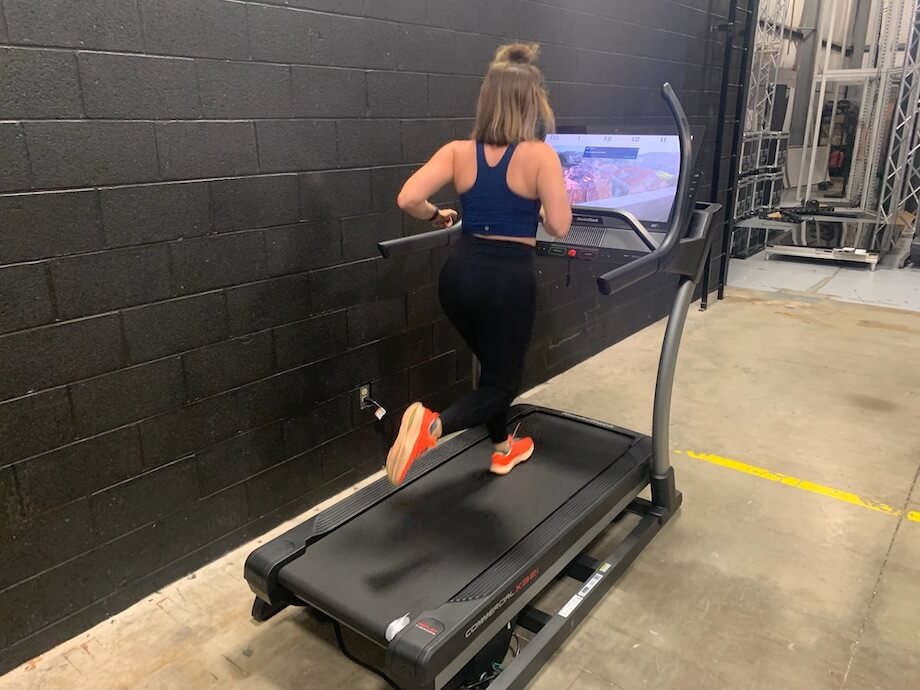
How to Do It
- Get on the treadmill, place your feet on the sides of the belt, and take hold of the guardrails on either side.
- Hit the start button, put your feet on the belt one at a time, and start walking.
- Take your hands off the handrail, adjust your speed and incline.
- Walk or run with proper form for time or distance.
Jump Rope
Using the jump rope is an excellent exercise to challenge multiple muscle groups and improve coordination and cardiovascular conditioning. After all, a million boxers can’t be wrong.
How to Do It
- Pick a rope that fits you right. You do this by standing in the middle, and the handles must reach your armpits.
- Hold the handles in each hand with a rope behind you.
- To start moving the rope, rotate your forearms forward, then your wrist to swing the rope overhead.
- When the rope is overhead, bend your knees and when the rope is at shin height, spring up from the balls of your feet to jump up.
- Stay on the balls of your feet the entire time for better technique.
RELATED: Jump Rope Exercises
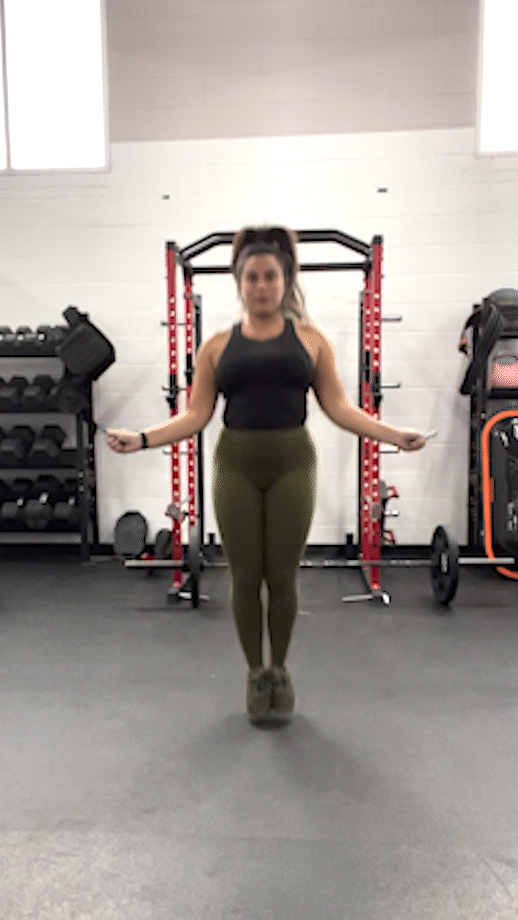
Elliptical
The elliptical machine is favored by many gymgoers because it simulates running in a low-impact fashion and burns many calories. The elliptical is a great endurance exercise if your knees bother you and you need to get some miles in.
How to Do It
- Step onto the elliptical facing the console, and turn on the machine.
- Start pedaling by pushing the elliptical pedals forward with your feet.
- Push and pull on both handles while following the instructions on the console to choose a pre-set program or selecting the manual mode in which you determine the intensity.
Stationary Bike
Indoor cycling is a great form of cardiovascular exercise that is low-impact, high-intensity, and burns many calories. Give the stationary bike a shot if you’re not a treadmill fan.
How to Do It
- Adjust the seat height so there is a slight bend in your knees on the pedal downstroke.
- With good posture and your shoulders relaxed, pedal keeping your elbow slightly bent and keep them close to your body.
- Avoid leaning on the handlebars too much, as this shifts the weight to the upper body, not the pedals.
Rowing Machine
Have you ever wondered why professional rowers have broad shoulders? You’re about to find out. Get on the rowing machine and experience full-body cardiovascular exercise that helps build muscle. Rowing is an excellent combo of cardio and strength training and can be used for low- or high-intensity exercise.
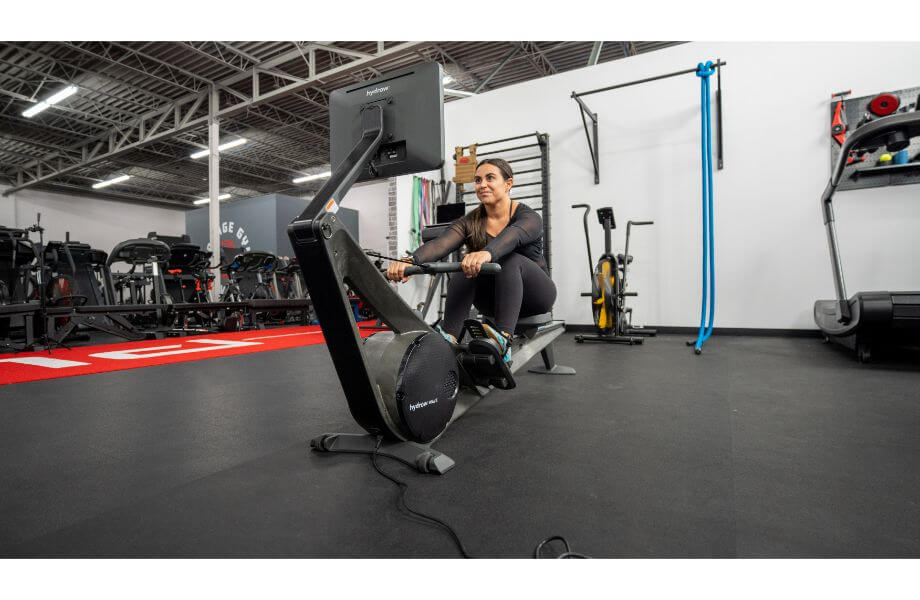
How to Do It
- Start with an upright posture looking straight ahead, engaged core with your feet tight in the straps and your arms straight.
- Proper rowing technique has four steps. First is the catch, which is your starting position.
- Second is the drive as you use your legs to push off and begin your stroke.
- Third, lean to about 100 degrees and pull against the flywheel with your arms.
- Lastly is releasing the resistance in your arms, bending your legs, and returning to the starting position to continue to the next stroke.
Battle Ropes
Battle ropes give you a high-intensity, low-impact workout that will challenge your heart and grip strength in a joint-friendly way. The foundational battle rope exercise is the alternating wave, which is explained below.
RELATED: The Best Battle Rope Exercises
How to Do It
- Stand up straight with your knees slightly bent and your core engaged.
- Keep your shoulders down and chest up back and hold one end of the rope in each hand.
- With a slight bend in your elbows, move your arms quickly up and down one after the other.
- Make sure the movement is coming from your shoulders.
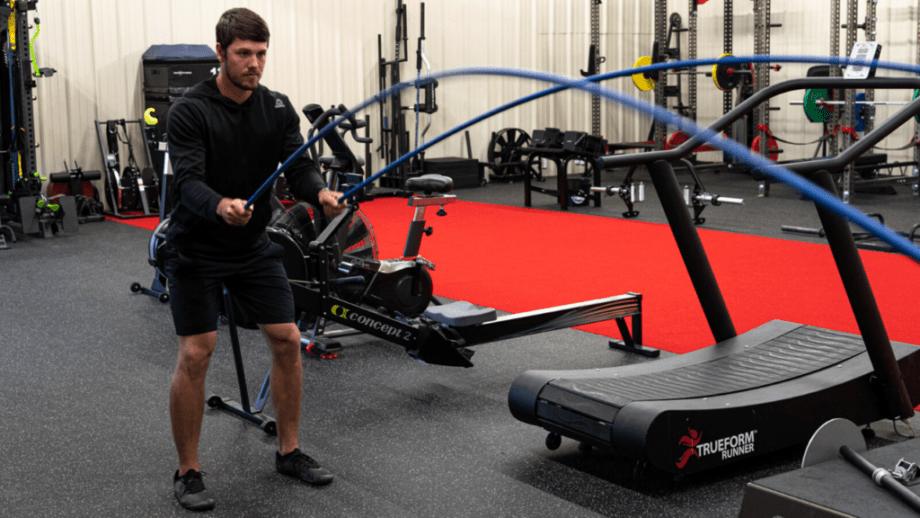
Benefits of Cardio Exercise
Yes, cardio exercise will burn calories and help you feel less guilty about your last night’s bowl of ice cream. Here are five essential benefits of performing regular cardio in your exercise program.
Reduced Heart Disease Risk
Improve your heart health! Regular cardiovascular exercise has been shown time and again to reduce heart disease risk1 factors like high blood pressure and high cholesterol by lowering LDL and increasing HDL (good cholesterol). Performing regular cardio will improve your overall cardiovascular health.
Stronger Bones
Weight-bearing cardiovascular exercise, like walking, climbing stairs, and even dancing, will help the bone remodeling process2, known as Wolff’s law, and therefore reduce your risk of conditions such as osteoporosis.
Improved Recovery
By improving your aerobic fitness, you improve your ability to carry away waste products of exercise through more efficient blood flow. Plus, improved blood flow brings healing blood to muscles damaged by resistance training to build muscle.
Better Work Capacity
Boosting the efficiency of your cardiovascular system improves your aerobic system and your ability to do more work, whether in the gym or on the sporting field.
Better Mental Health
You know you feel better after exercise, but do you know why? Well, it’s true that you typically get a boost of endorphins (the “feel good hormone”) when you exercise. However, cardiovascular exercises like jogging, swimming, cycling, walking, rowing, and dancing, have been proven to reduce anxiety and depression3.
Cardiovascular Exercises: Q&A
What is the best type of exercise for cardio?
This really comes down to your personal preference and what your goals are. If you need something easy to do, walking is a great choice. If you want to run a race, then running it is! If you want a total-body workout, then the elliptical or rowing machine may be best.
The American Heart Association4 recommends doing moderate-intensity activity for at least 150 minutes per week for optimal heart health.
What are four cardiovascular exercises?
The most common are running or jogging, cycling, rowing, and jumping rope.
Why are cardiovascular exercises important?
Improving your cardiovascular system is important so you’re less likely to die of the world’s biggest killer, heart disease. There are other benefits as well, such as boosting your mood, losing weight or maintaining a healthy body weight, improving bone health, and boosting your immunity.
References
- Johns Hopkins Medicine. Exercise and the Heart. Accessed November 2023.
- National Institutes of Health. Exercise for Your Bone Health. NIH Pub. No. 18-7879-E. Last Reviewed October 2018.
- Guszkowska M. Effects of exercise on anxiety, depression, and mood. Psychiatr Pol. 2004 Jul-Aug;38(4):611-20. Polish. PMID: 15518309.
- American Heart Association. American Heart Association Recommendations for Physical Activity in Adults and Kids. Last Reviewed: Apr 18, 2018
Further reading

It’s been a fun year of seeing fantastic new equipment, supplements, and apparel. Now the GGR Staff picks their top fitness releases of 2023. Read more

Break a sweat with our expert-tested picks for the best punching bags. Read more

There are many health benefits associated with sauna use, but are saunas good for your skin? We have the answer to this and more! Read more

You’re not the only one wondering: “Is CrossFit bad for you?” Luckily, we’ve got the full truth laid out for you here. Read more

